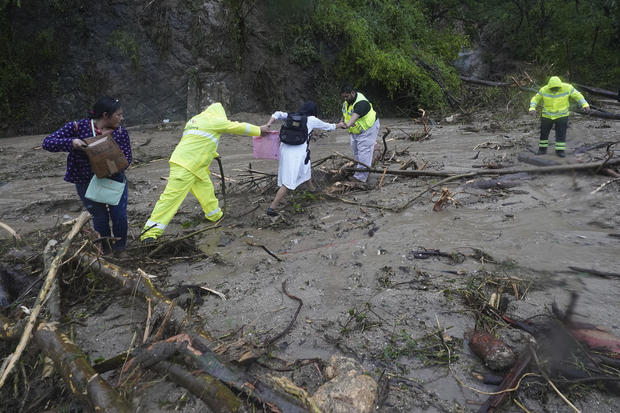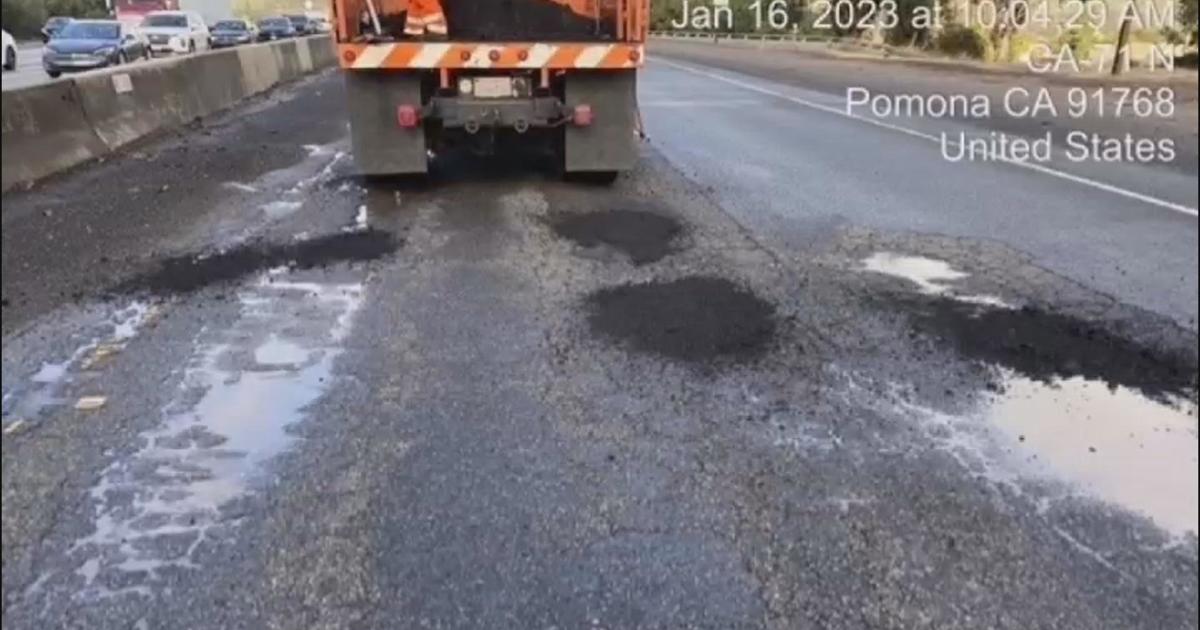Hurricane Otis causes damage, triggers landslides after making landfall in Mexico as Category 5 storm
Hurricane Otis barreled into southern Mexico's Pacific coast early Wednesday morning, making landfall as a dangerous Category 5 storm before weakening over land. By 6 a.m. local time, Otis dropped down to a Category 2 hurricane, packing maximum sustained winds of about 110 mph with higher gusts, forecasters said. The storm was expected to continue losing strength as it traveled inland before dissipating over southern Mexico on Wednesday night.
By midday Monday, Otis was a tropical storm with U.S. meteorologists reporting it had maximum sustained winds of 60 mph. The Saffir-Simpson Hurricane Wind Scale, which rates hurricanes using a storm's sustained wind speeds and estimates potential property damage, classifies a storm with sustained winds between 74 mph and 95 mph as Category 1. When a hurricane's maximum sustained winds dip below 74 mph, it then becomes a tropical storm.
The U.S. National Hurricane Center said Otis struck land near Acapulco, in Guerrero state, and warned that the area around the beach resort town could see "catastrophic damage." Videos posted online showed strong winds and rain lashing the popular beach resort city as the storm made landfall, and officials encouraged people in the path of the storm to shelter inside their homes if they could.
Mexican President Andrés Manuel López Obrador said at a news conference Wednesday morning that Guerrero was hit hard by the hurricane, which completely knocked out communications in the state. He said the government had not received any official reports of deaths linked to the hurricane. Otis damaged roads and caused landslides along a major highway leading into Acapulco, the president said, adding that crews were at work to fix the communications issue. Mexico's federal electricity commission said Wednesday morning that Otis had cut power to 504,340 customers, although it was later restored to 202,932 of those customers. Crews would continue restoring electricity supplies on site as soon as conditions allowed, the commission said.
The city of Acapulco set up 25 temporary shelters ahead of the storm. "If your home is at risk: Go to a shelter NOW," wrote Acapulco Mayor Abelina López Rodríguez on Facebook, while Obrador said on social media Tuesday that the government had coordinated with Guerrero officials to establish temporary shelters elsewhere in the state. He warned residents to keep away from rivers, streams and ravines in the wake of the hurricane.
Strong winds were still spreading inland over southern Mexico at 6 a.m., bringing heavy rain and flash flooding to some parts of the region, the hurricane center said. By midday, Otis was located around 130 miles north-northwest of Acapulco and traveling at about 10 mph, a moderate pace after the storm "explosively intensified" over the 24-hour period prior to landfall.
"Otis has explosively intensified 95 kt [about 110 mph] during the past 24 hours, a mark only exceeded in modern times by Patricia in 2015," the hurricane center said in an advisory released late Tuesday night, as Otis grew quickly into a Category 5 storm. At the time, forecasters added, "There are no hurricanes on record even close to this intensity for this part of Mexico."
Hurricane Patricia also hit Mexico's Pacific coast as a Category 5 storm when it made landfall in October 2015, bringing strong winds, rain and some landslides to cities like Puerto Vallarta, a resort hub and popular tourist spot, as well as the picturesque fishing town of Manzanillo. The storm did not cause major infrastructural damage.
Mexico's national civil protection agency said in a tweet that parts of Guerrero state were already seeing power cuts as the storm came ashore early Wednesday, and it warned residents in the area to remain calm and seek shelter until authorities confirmed that the danger had passed. The agency urged people to stay away from windows, disconnect electrical devices, avoid contact with water and metallic objects and to follow updates from official sources.
Otis strengthened from a tropical storm into a major hurricane within only about 12 hours before it made landfall at 1:25 a.m. CDT, according to the hurricane center. The storm slammed into Mexico's coast with maximum sustained winds of 165 mph and hurricane-force winds extending up to 30 miles from its center. Not long after making landfall it was downgraded to a Category 4 storm, with maximum sustained winds of 130 mph.
The hurricane center warned that "catastrophic damage" was likely as the eye of the storm moved onshore.
It was forecast to bring anywhere from 8 to 20 inches of rain through Thursday across the Mexican states of Guerrero and Oaxaca, and may also cause "life-threatening coastal flooding," as well as mudslides in areas with higher terrain. Potential storm surges and turbulent surf and rip current conditions were also considered life-threatening, meteorologists said.
The hurricane center warned of "extremely destructive winds near the core" of Otis, with powerful gusts posing a risk to the upper floors of high-rise buildings. Forecasters also cautioned that winds could become more powerful in areas of high elevation, saying that wind speeds "atop and on the windward sides of hills and mountains are often up to 30 percent stronger than the near-surface winds indicated in this advisory," posted at 7 a.m. local time when Otis' winds had fallen to 110 mph. A 30% increase would mean some higher terrains could be slammed with winds of up to 143 mph — equating to a Category 4 hurricane.
A storm is deemed a major hurricane when it reaches Category 3 or above on the Saffir-Simpson Hurricane Wind Scale due to the potential for "significant loss of life and damage," per the hurricane center.
A hurricane warning was in effect for Punta Maldonado west to Zihuatanejo throughout the morning Wednesday. Officials discontinued the hurricane warnings for areas west of Acapulco when Otis was downgraded to Category 1, replacing them with tropical storm warnings from Acapulco to Punta Maldonado.
Mexico's army and navy deployed more than 8,000 troops to Guerrero, an impoverished state plagued by violence linked to organized crime, with specialized equipment to aid in rescues.
Authorities closed Acapulco's port, home to some 300 fishing boats. The beach city, which has a population of about one million, is a major tourist destination.
"We're on maximum alert," Acapulco's Mayor Abelina López said Tuesday night, according to the AP, urging residents to either stay home or seek safety in one of the shelters set up in the city.






